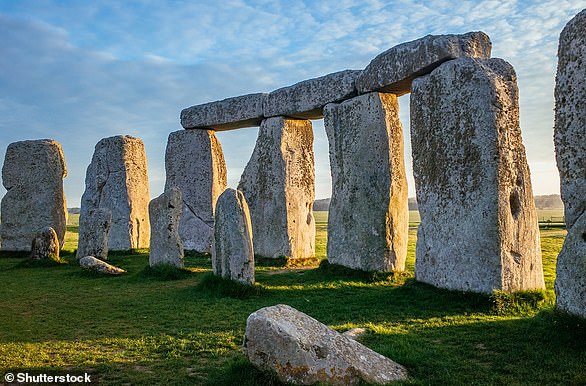Stonehenge Altar Stone Is SCOTTISH: The crucial rock was found in the Orcadian Basin before being transported 460 miles to its final resting place in Wiltshire 5,000 years ago, a study claims

Stonehenge is one of the most prominent prehistoric monuments in Britain. The Stonehenge that can be seen today is the final stage, completed around 3,500 years ago.
According to the monument’s website, Stonehenge was built in four phases:
First phase:The earliest version of Stonehenge was a large earthwork or henge, consisting of a ditch, a rampart and the Aubrey Holes, all probably built around 3100 BC.
The Aubrey Holes are circular pits in the chalk rock, about a metre wide and deep, with steep walls and flat bottoms.

Stonehenge (pictured) is one of the most striking prehistoric monuments in Britain
They form a circle with a diameter of about 86.6 meters (284 feet).
During excavations, cremated human bones were found in part of the lime fill. The holes themselves were probably not intended to serve as graves, but as part of a religious ceremony.
After this first phase, Stonehenge was abandoned and remained untouched for over 1,000 years.
Second phase: The second and most dramatic phase of Stonehenge began around 2150 BC, when some 82 bluestones were transported to the site from the Preseli Mountains in south-west Wales. It is thought that the stones, some weighing as much as four tonnes each, were dragged on rollers and sledges to the waters at Milford Haven, where they were loaded onto rafts.
They were transported by water along the south coast of Wales and up the rivers Avon and Frome, before being towed overland again at Warminster and Wiltshire.
The last part of the journey was mainly by water, via the River Wylye to Salisbury and then over the Salisbury Avon to West Amesbury.
The journey was almost 385 kilometers long and when they arrived at the site, the stones in the center were placed so that they formed an incomplete double circle.
During the same period, the original entrance was widened and a pair of Heel Stones were erected. The nearest section of the Avenue, which links Stonehenge to the River Avon, was built in alignment with the midsummer sunrise.
Third phase:The third phase of Stonehenge, which occurred around 2000 BC, was marked by the arrival of sarsen stones (a type of sandstone), which were larger than the bluestones.
They probably originated from the Marlborough Downs (40 kilometres north of Stonehenge).
The largest sarsen stone transported to Stonehenge weighs 50 tons. Transport by water was not possible. It is believed that the stone was transported using sledges and ropes.
Calculations have shown that it took 500 men with leather ropes to pull one stone, and another 100 men to put the rollers in front of the sledge.
These stones were arranged in an outer circle with a continuous series of lintels – horizontal supports.
Within the circle, five trilithons – structures consisting of two upright stones and a third stone on top as a lintel – were placed in a horseshoe shape. These can still be seen today.
Final phase:The fourth and final phase occurred just after 1500 BC, when the smaller blue stones were rearranged into the horseshoe and circle shapes we still see today.
The original number of stones in the bluestone circle was probably around 60, but these have since been removed or broken. Some still lie as stumps below ground level.
Source: Stonehenge.co.uk




